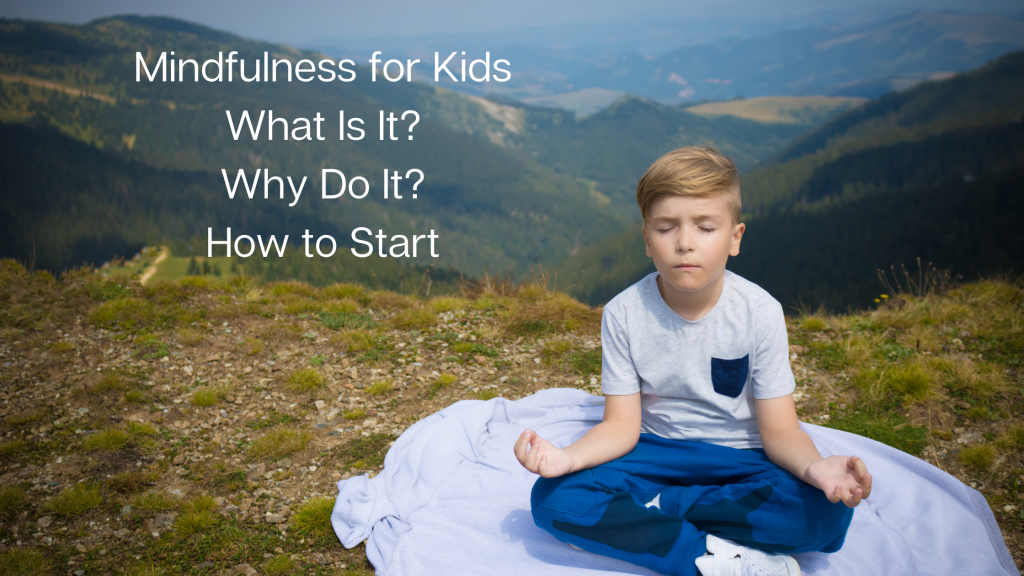Do you want to improve your child’s confidence and overall mental health? Studies show that practicing mindfulness for kids improves kids’ mental health and is teaching children resilience.
So, what is mindfulness?
The Oxford Dictionary says:
Mindfulness is “a mental state achieved by concentrating on the present moment, while calmly accepting the feelings and thoughts that come to you, used as a technique to help you relax.”
But mindfulness does way more than help us relax. It helps us visualize positive things. We develop empowering, ongoing attitudes about ourselves and others. Practicing mindfulness also helps us bounce back from negative experiences or circumstances.
Why should we practice mindfulness in our families and classrooms?
Declining mental health in children has been a trend for several years now. Add the pandemic; we’re seeing unprecedented numbers of anxious and/or depressed kids.
Practicing Mindfulness is a simple, yet effective, way to help our kids!
And the bonus: You’ll feel better too!
Remember, our brains need to feel safe to do our best thinking. It’s hard to understand new things, much less apply new concepts to what we know, if our minds are stuck in the limbic system, or the emotion centers in our brain.
In previous posts, I’ve told you how 10 minutes of exercise and a drink of water boosts brainpower. You’ve also learned how playing quick games that improve working memory also reduce stress and can help kids do better in school.
Part of the reason exercise, water, and working memory games increase our ability to process input is these things also reduce anxiety. They allow our minds to get out of the limbic system and into the thinking centers of our brain.
Mindfulness for kids is another tool that not only quells anxiety, but it lifts our spirits (i.e. stimulates production of serotonin, a happy hormone) and helps us to shift into a more positive mindset.
But whether your kids (or students) are stressed, including some mindfulness in their day has LOTS of benefits.
- Studies show mindfulness training builds resilience; that is, the ability to bounce back from disappointment or a negative experience.
- Mindfulness boosts thinking and focusing power for better performance in school.
- We reboot our sympathetic and parasympathetic nervous systems, our balance between action and rest, when we engage in mindfulness activities, largely because of the deep breathing involved. That’s the science-y way of saying it helps us relax.
- Kids who do mindfulness activities tend to get better at getting along with others and have more confidence too.
Now you know the what and why about mindfulness for kids — I bet you’re ready for the HOW TO.
Mindfulness for Kids (and you) in 5 Easy Steps
1. Set aside about 5 minutes to spend with your kids on mindfulness daily.
Kids do well with routine, and as with most activities we do for our mental or physical health, consistency is key.
Choose a regular time — in the morning, for example, to instill a sense of well-being and confidence throughout the day.
2. Ask your kids to close their eyes — and close your eyes too.
Children watch our every move, both consciously and subconsciously, to learn how to navigate their world. It’s important for you to do the mindfulness exercise with them.
3. Inhale, to the count of 4 — exhale, to the count of 6, at least three times.
There are several suggested breathing patterns, but this is a good place to start with children. The longer exhale helps to balance the nervous system between action and rest.
Count rather quickly aloud with children as you breathe together. Their size will cause their breathing capacity to be a bit smaller than yours.
Counting aloud will help all of you to concentrate on your inhales and exhales. If your minds start to wander, counting aloud will also help to get back to focusing on your breath.
Once you’ve gotten into the habit of doing mindfulness activities together, you may be able to count aloud for the first couple of breaths and then go silent. Your kids will likely let you know when they’re ready for you to stop counting aloud.
4. Play mindfulness music.
There are tons of free phone apps to choose from. Music isn’t mandatory, but it helps to release our minds from interrupting thoughts and slow our brainwaves into a relaxed state for health and well-being.
One of my favorite free apps is “Relax Yoga Music”.
5. Guide your children through visualizing something positive during the day.
After you’ve done 10-20 deep breaths together to music, one to two minutes, take your children through a positive visualization.
The beauty of taking 5 minutes to do this with your kids daily is that you can apply whatever struggles they’ve recently experienced. Mindfulness can set them up for a good day and give them a tool to deal with their circumstances.
Example, your child is having trouble with a friend or other peer at school and you say something like:
“See yourself moving through the day with confidence. You feel strong and empowered. Any negativity rolls off you. You replace negativity with knowing you are loved. God loves you. We love you, and you love and respect yourself. You mentally send love to those who need love and understanding, even though you may feel their behavior doesn’t deserve such kindness. You remember that usually when we deserve love the least is when we need love this most. You see yourself confident, kind, and patient.
Now wiggle your fingers and toes. Come back to your conscious mind. Open your eyes slowly, and have a lovely day.”
We’d love to hear your thoughts and about your experience with mindfulness, with your kids and on your own in the comments.
Have a wonderful mindful day!
Remember, if you’re dealing with something with your kids and you’d like some professional support, you can schedule a complimentary call with me. You’ll be glad you did. I promise. 😊
Best wishes on your parenting journey,
Trish Wilkinson
Coauthor Brain Stages: How to Raise Smart, Confident Kids and Have Fun Doing It Founder Brain Stages Parenting


